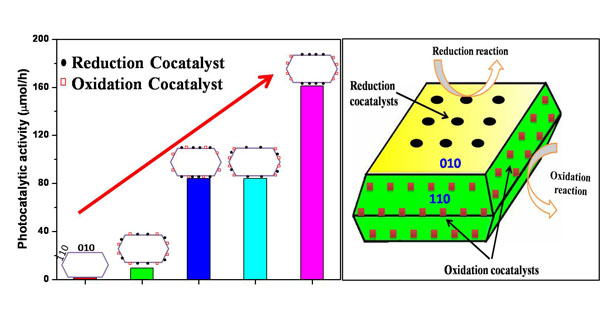The research on photocatalytic splitting of water and CO2 reduction for solar fuel production has been drawing great attention due to the increasing concerns on energy and environmental problems. These two reactions are energetically uphill and require multi-electron transfer, particularly the water splitting is regarded as the Holy Grail of science. The key to achieve photocatalytic water splitting and CO2 reduction is to develop efficient water oxidation photocatalyst and construction of efficient overall water splitting photocatalytic or photoelectrocatalytic systems.
Following the discovery of the effect of photogenerated charge separation on different facets of BiVO4 (Nature Commun., 4, 1432, 2013), extensive research has been carried out by the Solar Energy Division (DNL 16) at DICP, led by Prof. Can Li. They have been developing semiconductor crystal based photocatalytic system by selective deposition of oxidation and reduction cocatalysts on different facets of semiconductors. They found that the photocatalysts with selectively deposited dual cocatalysts can show up to two-order of magnitudes higher photocatalytic activity compared to the bare photocatalyst. They confirmed that the deposition of oxidation and reduction cocatalysts only on specific facets could lead to the synergetic effect, resulting in the significantly enhanced photocatalytic activity. They further found that the as-designed photocatalysts also show remarkably enhanced activity in photocatalytic degradation of pollutants. This work further demonstrated that the selective deposition of dual cocatalysts on different specific facets of semiconductors could be applied as a general strategy for developing the highly efficient semiconductor-based artificial photosynthesis system (Energy Environ. Sci., 2014, DOI:C3EE43304H

This work has been financially supported by NSFC and MOST 973 program (Reported by Rengui Li & Hongxian Han).